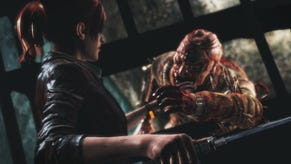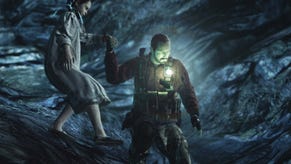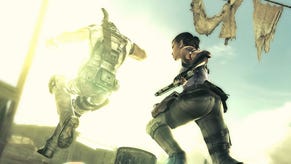Resident Evil Revelations 2 review
'You were almost a genre sandwich!'
This is our final review of Resident Evil Revelations 2. For our thoughts on the first episode, head over here.
Resident Evil Revelations 2 consists of four main episodes, plus two 'bonus' missions, and finally it is complete. When looking at the (great) first episode I chewed over the nature of a spin-off and covered the main mechanics, and in the final three episodes there are no major changes to the latter - beyond a few new guns. The best thing about these episodes, the bulk of Revelations 2's campaign content, is that the quality and atmosphere is maintained - but finally we get some flair.
This was always more of a problem with the episodic structure than the game itself, but the first part of Revelations 2 did good things without ever quite pressing the Big Red Button. Right from the off with the second episode you're being plunged into more dangerous situations and interesting environments, while the enemies get deadlier.
As a whole, Revelations 2 is the Resident Evil formula with plentiful modern tweaks, a game that feels current while also channelling plenty of nostalgia. What is truly impressive in fact may be the context of its parent series - a barnacle-clad behemoth forever voyaging, beloved by devotees and scorned as archaic by detractors. You could call Revelations 2 formulaic, in places, but you couldn't call it archaic: the slick movement and fast-paced gunplay definitively consign tank controls and zombies to the dustbin.
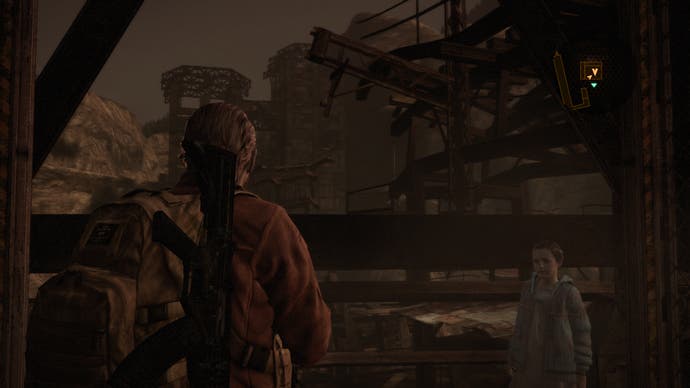
What impressed me the most in Revelations 2 is the enemies. The Ganado design of Resident Evil 4 soon became a standard, and Capcom re-used them more or less wholesale in Resis 5 and 6. While you'll definitely notice the odd familiar animation, the big difference in Revelations 2 is speed. You'll clock one at the end of a corridor and, just like old times, begin lining up the distance headshot. But now they run straight for you, and not in the aimless way of old. Got a height advantage? They'll leap up in a flash. You miss one shot and these enemies are on top of you, often swinging multiple times in a single attack, and getting floored just once can mean a deathswarm.
I died more in Revelations 2 than in any other recent Resident Evil. It's great to come across a few enemies unaware of your presence and consider your approach, rather than instant Rambo mode, because they're some kind of a threat. It's even better when you get cocky and they swiftly remind you that a pistol has many qualities, but stopping power is not among them. It's not that I enjoy dying, or 'wasting' green herbs on small encounters. It's that the enemy footsoldiers in Resident Evil had become over-familiar, and it's great to feel unsure again. We'll come to the spectacular stuff, but it's important to acknowledge that the majority of your time in a game like this is spent fighting 'normal' enemies, and so improving such engagements automatically lifts the entire experience.
Revelations 2's environments also play their part in making combat feel so dangerous. A theme throughout is darkness, illuminated in spots by a character's flashlight and Capcom's gorgeous lighting effects, which both hampers your sight and offers countless dark corners for foes to lurk. Combine this with narrow corridors that wind around each other and the necessity to occasionally split up characters (only one of whom has a light source) and the set-up is almost too perfect for jump scares. The cherry on the cake? Director Yasuhiro Ampo knows that less is more. Revelations 2 gave me a proper scare, more than once, and it manages this by passing up more obvious opportunities and lulling you into complacence.

When you escape the darker environments into somewhere well-lit, it's almost like hearing that safe room music in the original Resident Evil. The very fact Revelations 2 makes 'normal' light feel like a great relief can only be applauded. It's the kind of thing horror games always nod to - dark, gloomy environs - but only go so far with, fearful of alienating the mainstream player (ha!) through daring to frustrate.
Not all the environments are like this, of course, and in Barry Burton's sections in particular there's much more open air and well-lit interiors. The small island setting isn't enormously coherent, containing as it does a prison, various residential camps, a sewer system worthy of New York, a mine, a small mansion, and of course a huge underground lab. But the transitions are managed well and (as ever) the tiny snippets of text you find scattered around do a better job of building atmosphere and history than the cutscenes.
The one problem with this grab-bag of places is that, because there are so many flavours, every one is brief. This doesn't necessarily matter when you're tramping between settlements and waterways. But when, in the fourth episode, Barry enters a door in a mountain and finds himself in a mock mansion, you're at once overcome with joy and then, half an hour later, rather disappointed to leave so soon.
This highlights a strange aspect of Revelations 2. Resident Evil has always had backtracking - the first game was basically a maze, and you'd see certain rooms countless times. Here environments are re-used in a more linear fashion thanks to the conceit of Barry and Natalia's story taking place six months after Claire and Moira were on the island. This is not done in a lazy way - the effects of what happened can be seen, and the sections play out differently. But Revelations 2 has a strong through-line that pulls you ever-onwards meaning that, while you may see the same place twice, you don't care about memorising the layout or most efficient routes. Why bother when 90 per cent of the time you're moving from point A to B? In the context of other third person shooters this is standard. In the context of Resident Evil, something is missing. Fans don't love callbacks to the Arklay Mansion because they like the decor; it's because we know that space intimately.
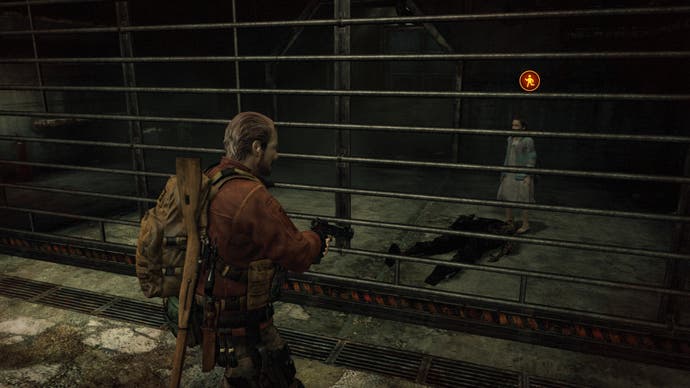
Still, such issues are minor next to the few occasions the game does put a foot wrong - and how. First there are invisible enemies that are, in proximity to your character, a one-hit kill. The initial encounters get away with it, because they're in open spaces, unusual and Natalia 'guiding' your aim by shouting "left, right, up, shoot now!" is a novelty. But when these foes begin to crop up more regularly, and in cramped environments, it's just frustrating. When they crop up in an endgame escape sequence where you have to sprint down extremely narrow routes it's just awful.
This escape sequence itself is the low point, and bizarre, given that the rest of Revelations 2 is assembled with such precision. It's a janky mess where, having spent the whole game stopping dead at platform edges, Claire suddenly decides that it's a great idea to forego such caution when running across narrow walkways suspended above the ocean. Inconsistency like this is awful design. In the five minute escape I died a total of seven times and, while a few of those can certainly be attributed to incompetence, most can be put down to falling off edges while trying to jump or - and this is astounding - Moira being downed by an invisible enemy, and control automatically switching to Claire just as the AI runs her into the same foe for a one-hit kill.
Nevertheless, such a bad five minutes does not come close to overshadowing the other eight hours of Revelations 2's campaign. The quality of the first Revelations was an achievement in itself, given how mediocre Resi spinoffs had been until that point (no, Code Veronica doesn't count). Revelations 2 is a more ambitious and original production, comfortable with moving further away from the main series and through this gaining a distinct identity. This is a Resident Evil game, but it also feels like its own game. Quite apart from the plot threads and sacrificial NPCs, that's the biggest revelation of all.



